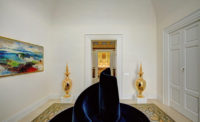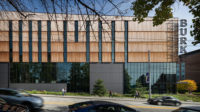Its name may be the Italian word for warehouse, but Magazzino, a privately owned art gallery in the quaint Hudson Valley village of Cold Spring, New York, hardly brings to mind the steely austerity one might associate with the term. Composed of two low-slung rectilinear volumes connected by two fully glazed corridors, its architecture is understated, ethereal. Yet the concept of a warehouse is central to the space’s identity—one of the structures, built in 1964, functioned for years as a storage facility for a computer manufacturer and, before that, as a distribution center for dairy products. The name alludes as well to the barren industrial spaces that were the backdrop of Arte Povera—the Italian movement of the 1960s and ’70s that celebrated unglamorous, everyday materials in defiance of commercialism in the art world—and Magazzino’s core content.
Additional Content:
Jump to credits & specifications
The gallery is the passion project of art collectors Nancy Olnick, an American and self-proclaimed Italophile, and her Sardinian-born husband, Giorgio Spanu. For Olnick, who comes from a prominent New York real-estate family, a love of accruing modern art seems to have been passed on from her patron parents (their collection included works by Alexander Calder, Willem De Kooning, and Agnes Martin). After she met Spanu, the two started to acquire Murano glass, eventually forming a 500-item collection that has been displayed across North America in a traveling exhibit conceived by the late designer Massimo Vignelli, who would later become a cherished friend.
A year-long hiatus in Rome in the early 2000s sparked an interest in the Arte Povera works, which the couple began avidly to collect, although many of the pieces were too large to fit in either of their two residences and had to be placed in storage. Magazzino was born of the desire to display their extensive collection—with works by Luciano Fabro, Michelangelo Pistoletto, and Jannis Kounellis—to the public. The couple paid for the $12 million project (the initiative does not have nonprofit status), and it is open to visitors free of charge by appointment. “We feel it’s our duty as collectors to be philanthropic, and Magazzino is our way of giving back and sharing our excitement,” says Olnick. Architect Miguel Quismondo was charged with bringing their vision to fruition.
The Spanish-born Quismondo, who started his career in the United States at Perkins+Will’s Miami office, was introduced to Olnick and Spanu by his friend and mentor, the architect Alberto Campo Baeza, also from Spain. Baeza, who had been commissioned—on Vignelli’s recommendation—to design the couple’s weekend house in Garrison, near Cold Spring, brought Quismondo on board as the project’s New York–based liaison and construction manager.
Since then, Quismondo and the couple have developed a rather unusual working relationship, which he jokingly compares to that of the Medici family and its architects. As Olnick and Spanu’s full-time “design advisor,” he has spent the last 14 years working for them in various capacities, from providing technical and construction support for the installations of site-specific artworks for the pair’s Garrison property to coordinating with contractors for renovations of Olnick’s real-estate holdings in New York City. “We’ve always had confidence in Miguel,” says Spanu. “We were very clear on our goals for Magazzino, and he was very clear on how to interpret them. I had no doubt that he was going to create a masterpiece.”
Quismondo deftly navigated the project’s challenges. He was given a decrepit 11,000-square-foot, L-shaped building located off a primary road, at the low point of a rolling landscape, adjacent to protected wetlands. The steel-and-concrete structure needed to be repaired and refurbished to include a small library and restrooms, and several distinct galleries. Because its footprint was too small and its height too low to accommodate many of the artworks, a bigger volume needed to be built alongside.
When the design team removed the building’s drop ceiling, they discovered steel joists and a roof of precast-concrete panels. “It’s such a simple and logical system—industrial perfection,” says Quismondo. “This was a warehouse, and we wanted to show it.” To expose these existing elements, rather than obstructing them with the HVAC system, the team tore up the floor slab and installed a radiant heating and cooling system, also used in the new building. Large, square windows were punched out of the walls, and a series of skylights installed to bring daylight into the space. The exterior was refinished in a smooth, white stucco.
For the new structure, which comprises gallery space on the ground level and offices and storage in the basement, Quismondo wanted something different in texture yet still in dialogue with its older neighbor. He designed a 14,000-square-foot rectangular building, its poured-in-place concrete frame exposed to lend a certain rawness. The addition runs parallel to the existing building, closing the L-shape with a glazed passageway to form a central courtyard.
Despite its larger size, the new volume does not dwarf its companion, but, rather, the two come together in a harmony of material and scale. The whole composition is a lesson in expert proportion, one that Quismodo learned from the man he calls his “father figure,” Baeza. Crisp sight lines guide circulation around the interior’s perimeter, framing the artworks, including the classical figures of Giulio Paolini’s sculpture Mimesi and a slate, metal, and neon igloo by Mario Merz—as well as views out to the landscape and across to different areas of the building.
Inside the new gallery, the extent of its height—less obvious from the outside—is revealed. This effect is enhanced by the even layer of daylight streaming through the milky translucent-glass-paneled ceiling. Entering this space from the older building, you feel a sense of release, of weightlessness; the artworks appear almost to float against the white backdrop. “The architecture and art are in a symbiotic relationship,” says Spanu, “but the art is the protagonist.”
Since opening in June 2017, Magazzino has laid the ground for a robust visitorship, with an average of 250 guests per week. A scenic 45-minute train ride from the city, it’s a welcome addition to the trove of Hudson Valley art destinations that include Storm King Art Center, Dia:Beacon, and Manitoga, the house and studio of modernist industrial designer Russel Wright. It’s still in its early stages, but Olnick and Spanu are determined to extend programming both on-site and off and to add visitor amenities such as a café, plus more galleries to highlight up-and-coming Italian artists. “We’re dedicated to keeping it as vital as we can,” says Olnick.
CreditsArchitect: MQ Architecture — Miguel Quismondo, partner in charge/
Engineers: Michael Carr (structural); Consulting Engineering Services (m/e/p/fp)
General contractor: Olspan
Client: Magazzino Italian Art |
SpecificationsCustom metal trusses Tino Yanitelli
Glazing Reynaers
Glass roof Kalwall
Skylights Wasco
HVAC Airfloor |











